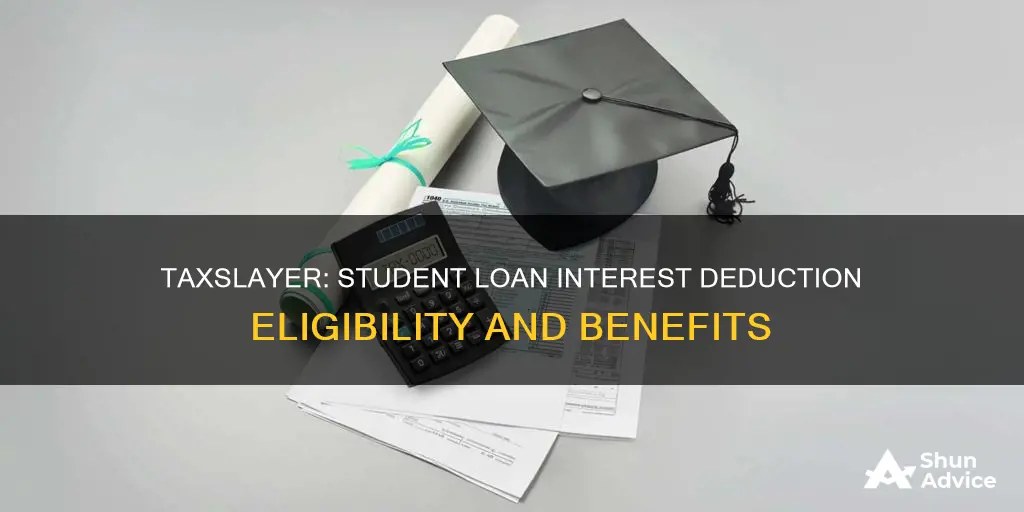
TaxSlayer is a tax software that can help you file your taxes and claim deductions for student loan interest. The software guides you through the steps of claiming the deduction, which can help offset a portion of your expenses. To qualify for the student loan interest deduction, your loan must meet specific requirements, such as being used solely for qualified education expenses, including tuition, fees, room and board, books, and supplies. Additionally, your filing status, modified adjusted gross income (MAGI), and dependency status must meet certain criteria to be eligible for the deduction.
| Characteristics | Values |
|---|---|
| Qualifying loan | A loan taken out solely to pay for education expenses |
| Education expenses | Tuition and fees, room and board, books, supplies, equipment, and other necessary expenses at a qualifying institution |
| Qualifying institution | Any college, university, vocational school, or post-secondary educational institution eligible to participate in a Federal student aid program run by the U.S. Department of Education |
| Claimable deductions | Interest on the loan, loan origination fee, capitalized interest, interest on a refinanced loan, and voluntary interest payments |
| Student loan interest deduction | Up to $2,500 per year |
| Form 1098-E | Received if you paid $600 or more in interest throughout the tax year |
What You'll Learn

Qualifying for student loan interest deduction
The student loan interest deduction is specific to the interest paid on a student loan. It does not apply to the principal amount. This deduction lowers your taxable income and can even lower your tax bracket in some cases. You can subtract up to $2,500 of interest paid from your income when calculating your adjusted gross income (AGI).
To qualify for the student loan interest deduction, you must meet the following requirements:
- You must be legally obligated to pay interest on a qualified student loan.
- The loan must be certified by the borrower as a student loan incurred solely to pay for qualified higher education expenses.
- Qualified education expenses include tuition and fees, room and board, books, supplies, equipment, and other necessary expenses at a qualifying institution.
- A qualifying institution is any college, university, vocational school, or post-secondary educational institution eligible to participate in a Federal student aid program.
- An academic period includes a semester, trimester, quarter, or other periods of study (such as a summer school session) as determined by an educational institution.
- An eligible student is someone who was enrolled at least half-time in a program leading to a degree, certificate, or other recognised educational credential.
- Qualified education expenses are treated as paid or incurred within a "reasonable period of time" before or after taking out the loan if they are paid with the proceeds of student loans that are part of a federal post-secondary education loan program.
- The student loan must be subsidised, guaranteed, financed, or otherwise treated as a student loan under a program of the federal, state, or local government, or of a postsecondary educational institution.
If you paid $600 or more in interest on a qualified student loan during the year, you should receive a Form 1098-E, Student Loan Interest Statement, from the entity to which you paid the student loan interest. This form will be used to report your student loan interest payments to the Internal Revenue Service (IRS) and to you.
Loans and Unemployment: Impact and Influence Explored
You may want to see also

Claiming student loan interest deduction
To claim a student loan interest deduction, you must meet the following requirements:
- You paid interest on a qualified student loan in the tax year 2024.
- You are legally obligated to pay interest on a qualified student loan.
- Your filing status is not married filing separately.
- Your Modified Adjusted Gross Income (MAGI) is less than a specified amount, which is set annually.
- Neither you nor your spouse, if filing jointly, were claimed as dependents on someone else's return.
The student loan interest deduction is specific to the interest paid on your student loan and does not apply to the principal amount. A qualified student loan is a loan taken out solely to pay for higher education expenses for you, your spouse, or a dependent. This includes tuition and fees, room and board, books, supplies, equipment, and other necessary expenses at a qualifying institution. The loan must be subsidised, guaranteed, financed, or otherwise treated as a student loan under a federal, state, or local government program, or a postsecondary educational institution.
The maximum deduction for student loan interest is $2,500 per tax return per tax year, which is gradually reduced and eventually eliminated by the phaseout when your MAGI reaches the annual limit for your filing status. You can claim this deduction as an adjustment to your income, so you do not need to itemize your deductions.
TaxAct's Loan Services: What You Need to Know
You may want to see also

Student loan interest statement
TaxSlayer offers guidance on claiming the student loan interest deduction on your tax return. This deduction is specific to the interest paid on a qualified student loan. It does not apply to the principal of the loan, which is not deductible.
A qualified student loan is certified by the borrower as a loan incurred solely to pay for education expenses. These expenses must be for a program leading to a degree, certificate, or other recognised educational credential. The program must be at a qualifying institution, which includes any college, university, vocational school, or post-secondary educational institution eligible to participate in a federal student aid program.
The student loan interest deduction is an adjustment to income, and the maximum amount you can write off is $2,500. This amount is reduced if your modified adjusted gross income for your filing status exceeds the limit set for the tax year.
To claim the deduction, you will need to receive a 1098-E Student Loan Interest Statement from your student loan servicer. This form will be sent to you if the interest you paid during the tax year met or exceeded $600. If you did not receive the form, you can download it from your loan servicer's website.
Target Employee Loans: What's the Deal?
You may want to see also

Qualifying student loan expenses
The IRS allows taxpayers to deduct interest paid on student loans, with eligibility and deduction amounts varying by income. The student loan interest deduction is specific to the interest you pay on your student loan. It does not apply to the principal amount, which is not deductible. If you paid $600 or more in interest throughout the tax year, your lender will send you Form 1098-E, which will report the exact dollar amount you can deduct on your tax return.
A "qualifying loan" is a loan you took out solely to pay for qualified education expenses. This includes expenses for you, your spouse, or a dependent. Qualified expenses are amounts paid for tuition, fees, and other related expenses required for enrollment or attendance at an eligible educational institution. Eligible expenses also include student activity fees that are required for enrollment or attendance.
Expenses for sports, games, hobbies, or non-credit courses do not qualify for the education credits or tuition and fees deduction, except when the course or activity is part of the student's degree program. For the Lifetime Learning Credit only, these expenses qualify if the course helps the student acquire or improve job skills. You must pay the expenses for higher education that results in a degree or other recognized education credential.
The American Opportunity Tax Credit offers up to $2,500 in annual tax savings for students in the first four years of a qualified degree program. The Lifetime Learning Credit supports ongoing education beyond the initial college years with a tax credit of up to $2,000 per year for qualified expenses.
TaxAct's Refund Anticipation Loans: What You Need to Know
You may want to see also

Student loan deduction limits
If you are paying off student loans, you may be able to deduct the interest paid on your student loan from your taxable income. This is called the student loan interest deduction. This deduction is specific to the interest you pay on your student loan and does not apply to the principal amount.
To be eligible for the deduction, you must meet the following requirements:
- You must have paid interest on a qualified student loan.
- You must be legally obligated to pay interest on a qualified student loan.
- Your filing status must not be married filing separately.
- Your modified adjusted gross income (MAGI) must be less than a specified amount, which is set annually.
- Neither you nor your spouse can be claimed as a dependent on someone else's tax return.
The maximum amount you can deduct is $2,500 per tax return per tax year. However, you can only deduct the actual amount of interest paid if it is less than $2,500. For example, if you paid $1,500 in interest, you can deduct $1,500. The deduction amount is gradually reduced and eventually eliminated as your MAGI increases. If your MAGI exceeds a certain threshold, you cannot claim the deduction.
To claim the student loan interest deduction, you will need to fill out Form 1098-E, which is provided by your lender if you paid $600 or more in interest during the tax year. This form will report the exact dollar amount you can deduct on your tax return.
Loans: Credit Score Friend or Foe?
You may want to see also
Frequently asked questions
A "qualifying loan" is a loan taken out solely to pay for education expenses for yourself, your spouse, or a dependent.
The student loan interest deduction allows students to deduct up to $2,500 per year for interest paid on loans taken out specifically for education expenses.
You may qualify for the student loan interest deduction if you meet the following requirements:
- You paid interest during the tax year on a qualifying student loan
- Your filing status is not married filing separately
- You are legally obligated to pay interest on a qualified student loan
- Your modified adjusted gross income (MAGI) is less than a specific amount set annually
- Neither you nor your spouse are claimed as a dependent on someone else’s return
If you received Form 1098-E, you can use the amount listed on the form to reduce your income.







